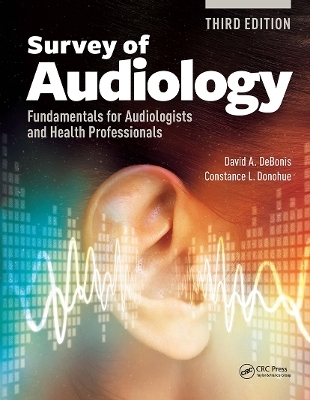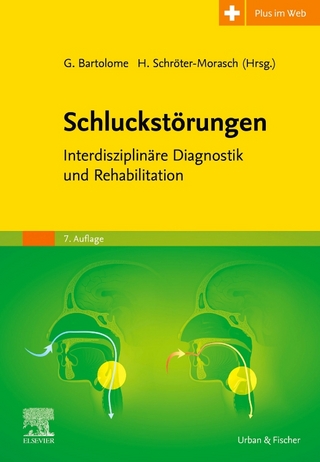
Survey of Audiology
SLACK Incorporated (Verlag)
978-1-63091-503-2 (ISBN)
For nearly 20 years, Survey of Audiology: Fundamentals for Audiologists and Health Professionals has provided both the breadth of an introductory survey of audiology and the depth of a detailed textbook. Inside, Drs. David DeBonis and Constance Donohue have combined their years of work in clinical settings and their experience teaching audiology into a textbook intended to give students all the knowledge they’ll need in the most accessible and comprehensible format.
In this Third Edition, updates have been made to include the latest information on the most current topics in audiology, including cognition and hearing loss, pharmacology, central auditory processing disorders, wireless technology, hearing aid accessibility, tinnitus, genetics and biotechnology, and noise exposure.
New and updated inside the Third Edition:
Ethical considerations for audiologists
Auditory Neuropathy Spectrum Disorder (ANSD)
Auditory processing disorders
Tinnitus
Evidence-based genetic counseling
The latest hearing aid technology
How to critically review evidence in literature and studies
Included with the text are online supplemental materials for faculty use in the classroom.
With its extensive glossary, numerous case examples, chapter abstracts, learning objectives, and questions for discussion, Survey of Audiology is designed to support learning and reinforce key points in every way. The text also works to integrate the humanistic aspects of audiology with the scientific ones into holistic discussions of assessment and intervention. Through this approach, students will learn to always remember that there is a person behind each set of symptoms.
While aspiring audiologists will appreciate the depth of Survey of Audiology: Fundamentals for Audiologists and Health Professionals, Third Edition, students of speech-language pathology and other health professions looking for a crash course in audiology will benefit from its readability and wide scope.
David A. DeBonis, PhD, CCC-A is a professor of Communication Sciences and Disorders at The College of Saint Rose in Albany, NY and a member of the audiology staff at Sunnyview Rehabilitation Hospital in Schenectady, New York. He has a master’s degree in audiology from The Pennsylvania State University in University Park, PA and a PhD degree in educational psychology from the State University of New York at Albany. David has over 30 years of clinical experience and 25 years of college teaching experience. He has co-authored and authored articles in several journals, including the American Journal of Audiology and the International Journal of Audiology. In 2014, he was awarded the Thomas Manion Outstanding Faculty Award at The College of Saint Rose. Constance L. Donohue, AuD, CCC-A is an audiologist and an adjunct faculty member at The College of Saint Rose in Albany, NY. Her experience includes nearly 20 years of teaching in the Communication Sciences and Disorders Program at the college. Connie received a master’s degree in audiology and hearing impairment from Northwestern University in Evanston, IL and a Doctor of Audiology degree from A. T. Still University of Health Sciences, Arizona School of Health Sciences in Mesa in 2013. Since 1998, Connie has worked in state government, including 15 years at the New York State Department of Health, where she helped establish and implement statewide newborn hearing screening. She currently serves as director of the Bureau of Early Intervention and oversees the Early Hearing Detection and Intervention Program.
Dedication Acknowledgments About the Authors Preface Introduction Chapter 1 Audiology as a Scientific, Collaborative, and Humanistic Discipline The Profession of Audiology Audiology as a Humanistic Discipline Recommendations for the Future Questions for Discussion Chapter 2 Acoustics of Sound and Preliminary Clinical Application Acoustics Standards What Is Sound? Units of Measure Application of Acoustic Concepts to Reading Audiograms and to Understanding the Listening Environment Fundamental Pathways of Sound Environmental Acoustics Questions for Discussion Chapter 3 Anatomy and Physiology of the Auditory System Anatomy and Physiology of the Peripheral Auditory System Anatomy and Physiology of the Central Auditory System Questions for Discussion Chapter 4 Pure Tone Testing Relationship Between Pure Tones and Perception of Speech Sounds The Audiometer Calibration Pure Tone Testing Masking Potential Pitfalls in Pure Tone Testing Questions for Discussion Appendix A: How to Mask During Pure Tone Testing Chapter 5 Speech Audiometry Contributions of Speech Audiometry Speech Audiometry Tests Masking During Speech Audiometry Other Issues in Speech Audiometry Questions for Discussion Appendix A: Selected Tests of the Minimal Auditory Capabilities Battery Appendix B: How to Mask During Speech Audiometry Chapter 6 Physiological Assessment of the Auditory System Acoustic Admittance Testing Tympanometry Eustachian Tube Testing Acoustic Reflex Thresholds Otoacoustic Emissions Auditory Evoked Potentials Questions for Discussion Appendix A: Answers to Tympanogram Cases 1 to 4 Chapter 7 Disorders of the Auditory System Selected Conditions That May Affect the Outer Ear Selected Conditions That May Affect the Middle Ear Selected Conditions That May Affect the Inner Ear Selected Conditions That May Affect the Central Auditory System Balance Disorders: Assessment and Management Questions for Discussion Chapter 8 Diagnostic Audiology With Children: Behavioral Methods Auditory Development and Pediatric Audiology Components of Auditory System Development General Principles of Pediatric Audiological Assessment Client-Specific Protocols for Audiological Assessment of Young Children Questions for Discussion Appendix A: Suggestions for Parents of Children With Middle Ear Problems Chapter 9 Assessment and Management of Special Populations Older Adults Individuals Who Are Deaf Adults With Developmental Disabilities People With Neurogenic Disorders Individuals With Nonorganic Hearing Loss Multicultural Issues Questions for Discussion Appendix A: Considerations for Hearing Assessment and Case Management of Individuals Who Have Developmental Disabilities Appendix B: Communication Strategies for Use in Individuals With Developmental Disabilities Chapter 10 (Central) Auditory Processing Disorders in School-Age Children Evidence Reviews and Clinical Practice (Central) Auditory Processing Disorders Nature and Development of Tests of (Central) Auditory Processing Maturation and Plasticity of the (Central) Auditory Processing System Traditional View of (Central) Auditory Processing Disorder Nontraditional View of (Central) Auditory Processing Disorder New Directions Regarding Auditory Processing Helping Children Who Have (or Are Suspected of Having) an Auditory Processing Disorder Final Remarks Questions for Discussion Appendix A: Sample Case History Form for Auditory Processing Evaluation Chapter 11 Screening Definitions and Models Decisions About the Screening Protocol General Screening Components Screening Protocols Across the Life Span Recent Trends in Hearing Screenings Questions for Discussion Appendix A: Sample Content to Include in Forms for Reporting Hearing Screening Results Appendix B: Hearing Screening (Adults) Appendix C: Hearing Handicap Inventory for the Elderly Chapter 12 Helping Individuals With Hearing Loss Model of Aural Rehabilitation Hearing Aid Amplification Treatment Planning Hearing Aid Selection and Fitting Process Verification Validation Assistive Devices Adult Aural Rehabilitation Implantable Hearing Aids Hearing Aids and Aural Rehabilitation in the Pediatric Population Cochlear Implants Tinnitus Prevention Counseling A Further Look at Diagnosis Through Aural Rehabilitation: Five Sample Cases Questions for Discussion Appendix A: Classroom and Educational Strategies for Consideration for Children With Hearing Loss Glossary Index
| Erscheinungsdatum | 01.07.2019 |
|---|---|
| Verlagsort | Thorofare |
| Sprache | englisch |
| Maße | 216 x 279 mm |
| Gewicht | 1170 g |
| Themenwelt | Medizin / Pharmazie ► Allgemeines / Lexika |
| Medizin / Pharmazie ► Gesundheitsfachberufe ► Logopädie | |
| Medizin / Pharmazie ► Medizinische Fachgebiete ► HNO-Heilkunde | |
| ISBN-10 | 1-63091-503-3 / 1630915033 |
| ISBN-13 | 978-1-63091-503-2 / 9781630915032 |
| Zustand | Neuware |
| Haben Sie eine Frage zum Produkt? |
aus dem Bereich


